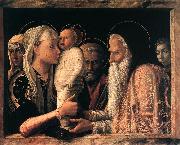Wholesale Oil Painting No Minimum |
|||||||||||
|
|
|||||||||||

|
|||||||||||
|
|
|
||||||||
MANTEGNA, AndreaItalian Early Renaissance Painter, ca.1431-1506 Italian painter and printmaker. He occupies a pre-eminent position among Italian artists of the 15th century. The profound enthusiasm for the civilization of ancient Rome that infuses his entire oeuvre was unprecedented in a painter. In addition to its antiquarian content, his art is characterized by brilliant compositional solutions, the bold and innovative use of perspective and foreshortening and a precise and deliberate manner of execution, an aspect that was commented upon during his lifetime. He was held in great esteem by his contemporaries for his learning and skill and, significantly, he is the only artist of the period to have left a small corpus of self-portraits: two in the Ovetari Chapel; his presumed self-portrait in the Presentation in the Temple (Berlin, Gemeldegal.); one in the Camera Picta (Mantua, Pal. Ducale) and the funerary bust in his burial chapel in S Andrea, Mantua, designed and probably executed by himself. His printmaking activity is technically advanced and of great importance, although certain aspects of the execution remain to be clarified. |
||||||||
|
|
||||||||
St Sebastian sg
St Sebastian sg Painting ID:: 8049 |
1456-59
Panel, 255 x 140 cm
Mus??e du Louvre, Paris 1456-59 Panel, 255 x 140 cm Mus??e du Louvre, Paris |
|||||||
|
|
||||||||
|
PERUGINO, Pietro Italian painter, Umbrian school (b. 1450, Citta della Pieve, d. 1523, Perugia). Italian painter and draughtsman. He was active in Perugia, Florence and Rome in the late 15th century and early 16th. Although he is now known mainly as the teacher of Raphael, he made a significant contribution to the development of painting from the style of the Early Renaissance to the High Renaissance. The compositional model he introduced, combining the Florentine figural style with an Umbrian use of structure and space, St Sebastian sg Wood, 170 x 117 cm Mus??e du Louvre, Paris |
||||||||
|
|
||||||||
|
Prev Next
|
||||||||
|
|
||||||||
|
Related Paintings to PERUGINO, Pietro :. |
||||||||
|
|
||||||||
|
CONTACT US |

